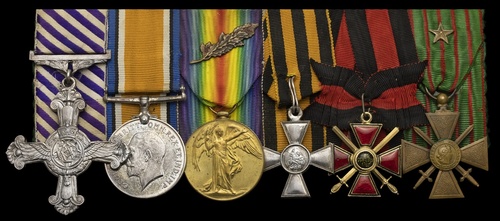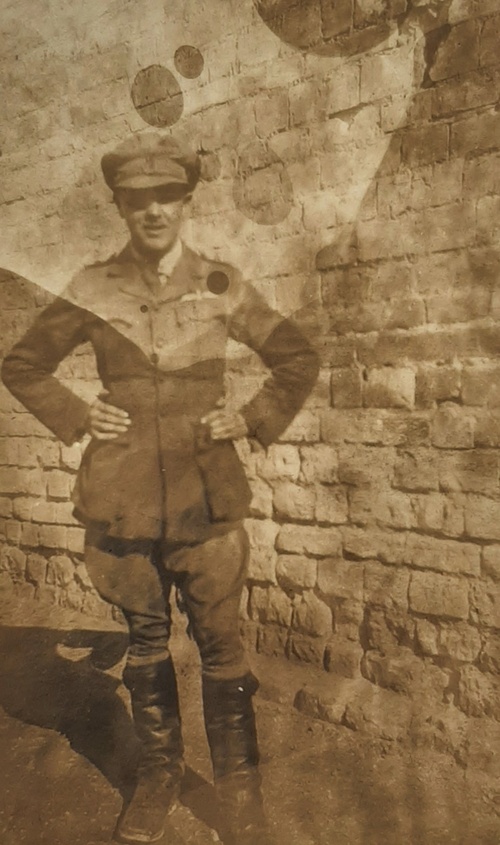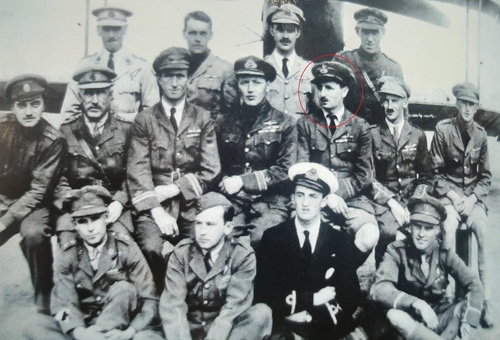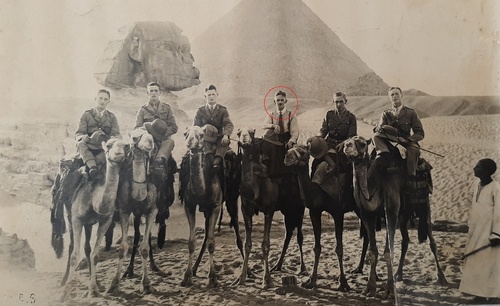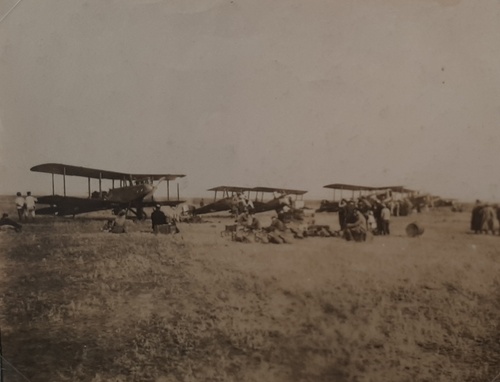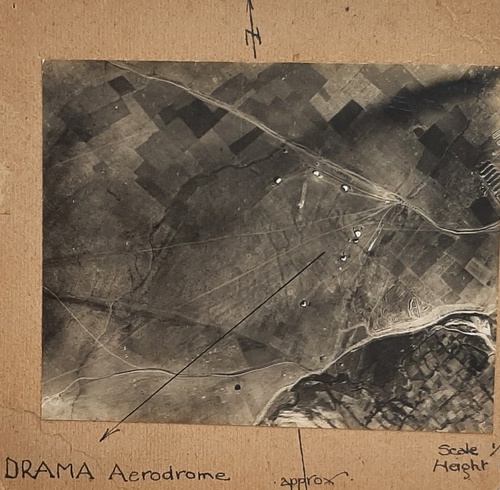Auction: 24003 - Orders, Decorations and Medals
Lot: 212
'A word is due here on Captain Davis. He was one of the original observers of No. 47 Squadron, joining the squadron in its early days in Salonika. He did excellent work over the Vardar front and was often chosen for the most difficult jobs. After a spell on that front he went to Egypt and qualified as a pilot. He returned to the squadron in 1918. He was a quiet, intense, stout-headed officers. He was sound rather than brilliant, and much of the fine work done by "C" Flight in South Russia can be traced back to his example.'
(Over the Balkans and South Russia, refers)
The superb Flight Leader's 'Salonika 1918' D.F.C., 'South Russia 1919' Cross of St. George and Order of St. Vladimir group of six awarded to Captain H. G. Davis, Royal Air Force, who was awarded the Orders of St. George and St. Vladimir by Baron Wrangel for his role in the Capture of Tsaristin - later Stalingrad - one of the great achievements of the White Army during the Civil War
Distinguished Flying Cross, G.V.R. (Capt. H. G. Davis); British War and Victory Medals (Capt. H. G. Davis. R.A.F.), with M.I.D. oak leaves; Russia, Imperial, Cross of St. George, 4th Class Badge, officially numbered '871001'; Order of St. Vladimir, with swords and bow, silver-gilt and enamel; France, Republic, Croix de Guerre, with Star, mounted court-style for wear, overall good very fine (6)
D.F.C. London Gazette 1 January 1919 (No. 47 Squadron).
Russian Cross of St. George, conferred 12 July 1919. The original citation states:
'[Awarded] by General Vrangel, Caucasian Army, for services in the Field during Tzaristin operations. 12th, July 1919.'
Over The Balkans and South Russia quotes two Russian awards to Captain Anderson of a St. George Cross 3rd Class No. 871,002 and his Observer, Captain McLennan who was killed, a St. George Cross 4th. Class No. 871,003.
Order of St. Vladimir, Order to the Caucasian Army. No. 290., 23 August 1919, the original citation states:
'The O.C. "C" Flight of the British Air Force Squadron No. 47, Capt. Davis, is rewarded with the Order of St. Vladimir 4th Class, with Swords and Bow, for distinguished service.
Croix De Guerre avec Etoile en Vermeil London Gazette 10 October 1919.
Harold George Davis was born at 29 June 1890 at Yardley, Worcestershire, the son of Henry and Agnes Davis of 11 Manley Road, Newport, Monmouthshire. Educated at the University of London he served with the Oxford University Officer Training Corps from 11 May 1915 before being posted to the 11th Battalion, Welsh Regiment. This unit was stationed in Salonika from October 1915 although it seems Davis did not join them until after 1915, he was later transferred to the 1st Battalion.
First Flight
Joining the Royal Flying Corps, Davis served as an Observer from 24 December 1916 with No. 17 Squadron. He transferred to No. 47 Squadron in February 1917 stationed at Salonica and qualified as a pilot there on 8 December. He began to fly missions in an A.W.12 single-seat fighter on artillery observation missions and bombing raids. Soon Davis was given command of 'C' Flight, Over the Balkans and South Russia outlines his role at this time:
'On "C" Flight, under Captain H. G. Davis, D.F.C., devolved primarily the duties of co-operation with the artillery. Daily this flight was occupied from morning till night with counter-battery work- wire-cutting- photographing the enemy lines and gun-positions, etc. The illustration of Guevgueli Bridge is a good example of their work.'
There are a number of after-action reports which note successful raids however one of particular interest is a handwritten report dated 18 September 1918:
'Whilst doing a destruction shoot [Artillery barrage] on Furka we were escorted by 4 SE5 As at about 0700 hours the 4 SE's were seen to attack a formation of E.A.s in the direction of Cestova. One E.A. we saw go down in a spin and flatten out near, the ground.
A second we saw go down in a spin but was not seen to flatten out again and probably crashed.
A third we saw, went down in a spin with columns of black smoke issuing from the machine.'
By the end of the Great War Davis was launching air raids around the Kresna Pass in Bulgaria. After the award of the D.F.C. he was further 'mentioned' (London Gazette 30 January 1919, refers) with the citation stating that it was for 'distinguished services rendered during the period of 1 March to 1 October 1018'.
South Russia
Volunteering for service in South Russia Davis on 23 April 1919 he was initially posted to Zimovniki in June, still in command of 'C' Flight. The formation was entrained there and taken to Gniloakaiskaya on 20 June, starting to fly bombing raids over Tsaristin on 23 June. The Battle of Tsaristin- now Volgograd- was just beginning with the White Russian Army of the Caucasus under General Baron Wrangel advancing on the town. The bombing missions largely targeted the docks, aiming to foil the flow of supplies through to town to the front.
An extract from Air Command by Air Vice Marshall R. Collishaw, outlines the role of the Squadron in Russia:
'In the meantime "C" Flight had gone into action. It train, which had left Ekaterinodar on June 10, had encountered many delays, some caused by wrecked bridges that had to be repaired before it could continue. On June 20 it arrived at the village of Gniloakaiskaya, about 312 miles to the northeast of Ekaterinodar and about 60 miles from Czaritsyn [Tsaristin], and established itself there, its DH9's operating from an improvised aerodrome adjacent to the railway sidings. Three of its machines flew a bombing raid against targets in Czaritsyn on June 23 and also strafed the enemy's river barges, groups of cavalry and troop concentrations. From then on, until the end of the month when Wrangel took the town, the flight was in the air daily, bombing and strafing a variety of targets, including rail and river transport and concentrations of cavalry and infantry. On one raid that the flight flew against Czaritsyn it dropped a 112-pound bomb squarely on a building in which the local Soviet was holding a full session. All but two of the 41 Red officials were killed. Particularly heavy damage was done to the light naval forces that the Reds were operating on the Volga, as well as to barges carrying supplies. Following the capture of the town Baron Wrangel was kind enough to send a letter of thanks for the work that 'C' Flight had done.'
As the front crept past Tsaristin it became increasingly difficult to reach their targets from Zimovniki. The problem was severe enough that that they attempted to move airfield to the newly taken Tsaristin airfield. Gone to Russia to Fight outlines what followed, stating:
'As the fighting was now moving away for C Flight's airfield, it was decided to move the aircraft up to Tsaristin. Captain Davis and Lieutenant Grigorieff flew to the airfield at Tsaristin that had been nominated for use by C Flight, but looking at the field from the air they decided that it was far too small ad had obstructions scattered across it, so they returned to Gniloaksaiskaya. When a White Russian Squadron of Nieuports tried to land on the field, three crashed, killing one Pilot.'
A somewhat frustrated extract from the Squadron War Diary adds to this stating:
'Capt Davis, Lt Clavey, Lt. Reynolds, pilots. Lt Mann, Lt. Hopwood and Lt. Grigorieff, observers, left aerodrome to bomb KAMYCHIN. Capt. Davis was forced to returned with "dud" engine. The other two machines successfully bomb barges on Volga, one machine setting at least two barges on fire. We are now over 120 miles from our targets, and the Russian Authorities, despite urgent requests, cannot get us barges to proceed up river. The railway is no good, as it runs N.W. and no point on it is affreciably [SIC] near than we are at present.'
It was not long later that Davis laid down command of 'C' Flight, being replaced by Captain Frogley. Gone to Russia to Fight give further detail on the presentation of medals by Wrangel for the work done in the fall of Tsaristin:
'Early in the month, General Wrangel had awarded the Russian George Cross Fourth Class to the five pilots and observers of the Original C flight for "Carrying out under hostile artillery fire air reconnaissance of the enemy positions and bombing which had valuable and important consequences for the army".'
Epilogue
Transferring to the unemployed list on 16 October 1919 the address listed upon his service paper was that of his father 'Rosecliff, Risca Road, Newport, Monmouthshire'. Little is known about the rest of his life, however Over the Balkans and South Russia does present one possibility, stating:
'After he left the Royal Air Force, when fighting had ceased, he went to Africa and (I am informed) died there, soon after his arrival, of blackwater fever.'
Sold together with a large research folder including several photographs both copied and original as well as copied research including, service papers, census data and book extracts as well as squadron war diaries and combat reports.
Subject to 20% VAT on Buyer’s Premium. For more information please view Terms and Conditions for Buyers.
Sold for
£6,500
Starting price
£6500
Sale 24003 Notices
Russian Imperial Awards of the Civil War Period (Rudichenko, 2007) further confirms the number of the Cross of St George is in the correct series for this award.

